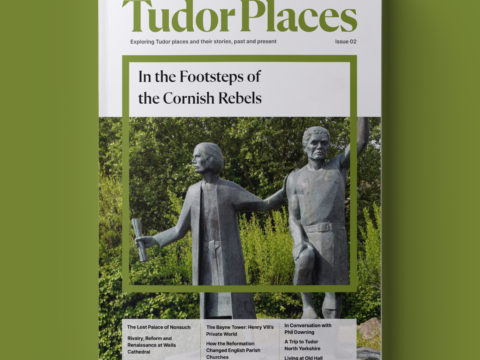Margaret Tudor: Life Story
Chapter 10 : At Henry VIII's Court
After some to-ing and fro-ing of letters, Henry invited Margaret and Angus to London. He sent various officers led by Sir Christopher Garnyshe, to convey her south, with all of the necessary apparel and plate she would need to put on a suitable show. A litter was provided and the silver vessels and the party set out from Morpeth on 8th April, arriving in Newcastle later that day, where the Mayor and Sir Thomas Parr were waiting to receive her. The next day she proceeded to Durham.
In his account of the matter, Dacre was forced to break the news to Henry that Angus was not accompanying his wife. He and Lord Home had made a deal with Albany and returned to Scotland. Margaret was ‘in much heaviness’, but would take Henry’s advice in the matter. Henry contemptuously characterised Angus’ departure as ‘done like a Scot’.
On his return, Angus renewed his relationship with Janet Stewart of Traquair, who, in due course, delivered a daughter, known as Lady Janet Douglas. He chose to set up home with Lady Janet in Margaret's own dower castle in Newark, a fact which, when it became known, enraged her far more than the simple matter of adultery. Angus has received much blame for this act of desertion of his wife and child. Presumably, in his own mind, it was his duty to preserve his family estates which were threatened with forfeiture.
Margaret arrived at Stony Stratford on 27th April, 1516. She wrote a short note to Henry, saying that she was ‘as joyous of my said journey toward you as any woman may be coming to her brother.’
The party arrived in London at the beginning of May, and Margaret stayed at Enfield at the Lord Treasurer’s house. The Treasurer was the Duke of Norfolk. Hall’s Chronicle does not say whether he was there, but if he were, it must have been a dreadful moment for Margaret to meet again the man who, as Earl of Surrey, had first conducted her to Scotland, and then had been responsible for James IV’s death.
On 3rd May, Margaret entered the city from Tottenham, as was the custom for visiting Kings of Scotland, Margaret riding on a white palfrey that Katharine had sent to her. A great train of ladies and gentlemen accompanied her to Baynard’s Castle, where she took to the river to travel to Greenwich. Sources differ as to whether Henry met her at Tottenham, or whether he and Katharine greeted her at Greenwich.
The court that year was known as the Court of the three Queens, Margaret’s sister, Mary having returned to England following the death of Louis XII. She had married the Duke of Suffolk, but was still treated as a queen, as would Margaret be, despite her marriage to Angus. In fact, according to the Venetian ambassador, Henry was refusing to recognise Angus as Margaret’s husband, on the grounds that, at the time of the marriage, Scotland had been under a papal interdict, and thus no marriages contracted during the period, were valid.
Part of the reason for wishing Margaret’s marriage to be considered invalid, was a plan to marry her to the Emperor Maximilian, whose second Empress, Bianca Sforza, had died in 1510. The matter does not seem to have been pursued with any great vigour. Perhaps Margaret was still sufficiently fond of Angus to object to her marriage being set aside, or perhaps Maximilian did not want to muddy the waters of his grandson, Charles’, inheritance.
Henry had summoned as many of his nobles as possible to attend the court although the Earl of Shrewsbury declined on account of plague in his household. The court was in good spirits, Queen Katharine having finally borne a live child, Mary. The birth of the princess had moved Margaret down the line of succession, but she had probably always anticipated that her brother would have children.
Despite being treated with all honour and affection, Margaret remained short of money. Over the period of her time in London, she wrote on at least two occasions to Wolsey, requesting him to lend her money. Ambassadors had come from Albany, and it had been agreed that she would receive her dower rights, but as yet, no money had been delivered.
Henry, who was certainly fond of his sister Mary, and perhaps of Margaret too, saw his sisters first and foremost as a means to take and retain power for his dynasty. His view was that a Scottish regency favourable to England was an outcome to be promoted by whatever means possible. It does not appear that, at this time, he had the complete subjugation of Scotland in mind, but he definitely wished to exert some control, continuing to insist that English kings were Scots kings’ overlords.
With only a daughter, Henry’s nearest male heir was Margaret’s son. At the very least if Henry could influence the boy through his mother, and, ideally, have him brought to England, the prospect of him inheriting might not be so bad. To achieve this, he needed Margaret in Scotland, not idling her time away at his expense in Westminster.
Henry, Wolsey and Albany therefore worked out a peace treaty which allowed Margaret to return to Scotland. They were met at Berwick by Sir Antony d’Arcie, Albany’s friend, who had also been a friend of James IV and as well as the bearer of Louis XII’s condolences after Flodden. Angus was also waiting for her and, ignorant as yet of the existence of Lady Jane of Traquair and her daughter, Margaret was willing to be reconciled.
Margaret, Queen of Scots
Family Tree




